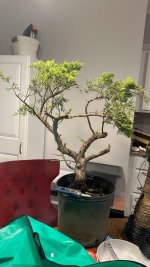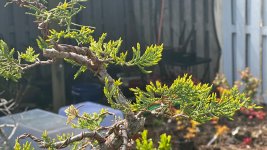Veebs
Yamadori
I’m sure a lot of us have heard about how you shouldn’t do major root work AND major pruning in a single season.
I’m assuming we are all defining “season” as spring to dormancy, but I would assume if you did significant pruning in winter it would be pretty unwise still to go hacking roots in spring.
I have a favorite juniper I’ve been working on. Here’s a record of activities:
- June 2024 - Initial rough pruning (and an embarrassing styling I won’t show you)
- September 2024 - Finally found the line and removed “all that is not bonsai”, but not much wiring.
- January 2025 - Wired and styled and reduced foliage to sparse starter pads.
I’ve attached a photo record of all that.
Now this tree is pushing its first initial growth. I want to work the roots as it’s been growing in this container for probably 15 years, but I love this tree and don’t want to risk it.
What’s your advice? Am I right to hold off, or safe to proceed?
I’m assuming we are all defining “season” as spring to dormancy, but I would assume if you did significant pruning in winter it would be pretty unwise still to go hacking roots in spring.
I have a favorite juniper I’ve been working on. Here’s a record of activities:
- June 2024 - Initial rough pruning (and an embarrassing styling I won’t show you)
- September 2024 - Finally found the line and removed “all that is not bonsai”, but not much wiring.
- January 2025 - Wired and styled and reduced foliage to sparse starter pads.
I’ve attached a photo record of all that.
Now this tree is pushing its first initial growth. I want to work the roots as it’s been growing in this container for probably 15 years, but I love this tree and don’t want to risk it.
What’s your advice? Am I right to hold off, or safe to proceed?





